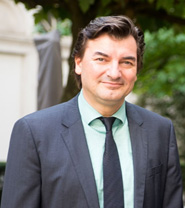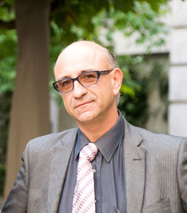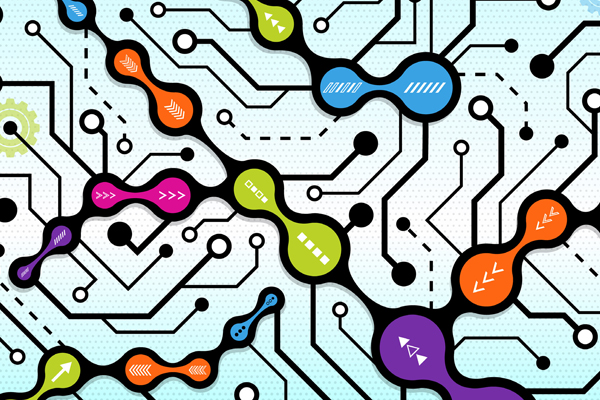There is still a great deal more innovation required in hardware if the intuitive Internet of Things is to be achieved. This includes advanced sensor modules and wireless communication chips that enable sensors to talk both with each other and with their environment. But if we want to see a reliable, secure and efficient IoT, we will also have to make a lot more effort in terms of digital technologies and software. Rudi Cartuyvels, Executive Vice President Smart Electronics at imec, and Danny Goderis, Executive Vice President Smart Applications at imec and the former CEO of iMinds, explain the main developments in their fields and give us a taster of what the interaction between microchip and digital technology can create.
Enabling the wireless connectivity of sensors
A functional Internet of Things is inextricably linked with reliable wireless communication that enables the various sensors, equipment and machines to ‘talk’ both with each other and with the cloud. Rudi Cartuyvels: “For that to happen you need wireless communication chips for the IoT’s sensor networks. The sensors in these networks will be powered by batteries and that’s an area that poses an enormous challenge for us: at the moment we only have very low power available to supply the communication chips. In addition to that, the wireless communication chips have to be capable of transmitting data over a relatively long distance (we’re talking about kilometers here). They also need to comply with the communication standards proposed for the IoT, just as for Wi-Fi and Bluetooth Low Energy.” Imec and Holst Centre have built up many years of experience in designing ultralow-power communication chips. Rudi Cartuyvels: “We again had excellent results in 2016, such as at the ISSCC conference. Our achievements included developing a transceiver that is optimized for IoT applications and which is in line with the low-power, long-distance Wi-Fi protocol IEEE802.11ah. We are also working on solutions that meet the Bluetooth Low Energy standard for IoT applications, as well as looking at combined solutions that incorporate Bluetooth and Wi-Fi on the same chip.”
One obvious solution would be to use the cellular phone network that is available everywhere. Rudi Cartuyvels: “At the moment we are not yet able to use this technology in sensors because it uses too much power. However, we are working on solutions that comply with the narrowband IoT standard and which ultimately will enable sensors to communicate over long distances via the cellular network.”
Sending large volumes of data wirelessly
Data speeds ranging from kilobits to megabits per second are sufficient for sensor networks. But what happens if large volumes of data have to be sent wirelessly and at high speed? Researchers of imec – UGent – IBCN (a former iMinds research group) are working on ultrahigh-speed wireless connectivity that uses ATTO technology. Danny Goderis: “ATTO technology is a development from wireless ‘small cells’ technology in which large numbers of antennas each cover a limited area (or cell) to make fast wireless broadband connections possible. Professor Demeester’s team aims to check whether this technology can be used to provide each object in large groups of moving objects with a superfast mobile connection of 100Gbits per second and as little signal delay as possible.” Professor Demeester was awarded an ERC grant for this work in 2016. He will use the funds to develop the technology further over the coming years. Initially, the technology will be used in production environments to enable flexible swarms of intelligent robots to work in harmony with humans. Danny Goderis: “But we also hope to lay the foundations for a whole series of other mobile applications that need high levels of fast calculating power. And I see ATTO as an enabler for the ‘mass customization of products’, a trend that I believe in strongly. Mass customization, as opposed to mass production, will enable customers to adapt products to their own requirements. Intelligent robots that can be reconfigured quickly – and preferably wirelessly – will be needed to do this.”
An alternative way to transport huge amounts of data makes use of millimeter wave technology. Rudi Cartuyvels: “We will need to be able to send large amounts of data from the sensor networks to the cloud, at very high speeds and wirelessly. We are looking at wireless solutions that will reach speeds of up to 20Gbits per second, using millimeter wave technology in 60GHz. We use beamforming for this, which enables directional signal transmission between a transmitter and a receiver, at very high speed. In 2016 at ISSCC we worked with the Vrije Universiteit Brussel and Holst Centre to present a low-power demonstration chip in 28nm CMOS technology for 60GHz communication. We were able to achieve data speeds of almost 5Gbits per second over a distance of 1 meter. At the imec campus, we demonstrated data rates of 1.5Gbits per second over 100m distance. We are currently working on solutions that will enable even higher data speeds and a longer range.”
Testbed
Ultimately, the technologies used for the IoT (such as sensor platforms and wireless communication technologies) must also be linked with each other and be rolled out to scale in a genuine test environment. Rudi Cartuyvels: “At imec we have a great deal of expertise in developing integrated wireless sensor modules, for example for measuring ambient gases, fluids or body parameters. But it is also very important to know how these technologies behave in ‘real life’. As a result, working with the former iMinds (now merged with imec) is very important. They have a lot of experience in setting up testbeds that enable technologies to be validated.” The flagship project is the City of Things in Antwerp, Belgium, in which researchers will roll out a hundred gateways and a multitude of sensors in a city infrastructure by the end of 2017. “But the software is also important,” says Rudi Cartuyvels. “In the end, we also need to have a software platform capable of controlling and managing the hardware components. One of the challenges here is the heterogeneity of the network: a lot of different technologies will have to work together as part of the same network.” Here again our expertise in digital technologies will come into its own. Danny Goderis: “In the Internet of Things there will be far more ‘any-to-any’ connectivity than in a conventional network. To be able to run and manage that network, you need sophisticated tools. Our researchers are developing these operations management (or OM) systems. We are working on a plug-and-play design that will give us a simple way of plugging in sensors and wireless interfaces so that they can then be programmed, upgraded, monitored or managed. We produced a prototype for this in 2016.”
Safety first
One of the major challenges facing the IoT is protecting the data that will be collected by all of these sensors in our home, on our body or in our car. Rudi Cartuyvels: “In the future, data security will become extremely important. Furthermore, standards will have to be created that people will have to comply with before a device can be connected with a networked environment. Data protection will be a combination of both software and hardware security.” However, security at a sensor or chip level is not so straightforward in view of their limited calculating power and battery content. Danny Goderis: “There are already methods in place today, such as complex cryptographic algorithms, for protecting devices against hackers. But these forms of security require a great deal of calculating power and energy. At imec – KU Leuven – COSIC (a former iMinds research group) new ways of securing microchips are being investigated. In 2016 Ingrid Verbauwhede was awarded a European ERC Advanced Grant that she will use over the coming five years to develop new protective mechanisms for making electronics more resistant to abuse. ” This is another fine example of what the interplay between hardware and software can create…”.
Authors:













